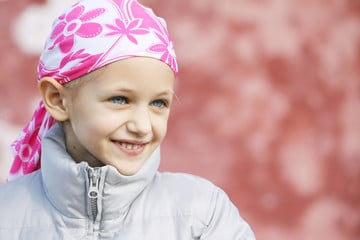Exercise for Childhood Cancer Patients

Childhood cancer (also called pediatric cancer) typically means a cancer that is found in children and teens, and sometimes young adults. It is not just one disease. There are many types, which can be found in different places throughout the body.
The most common cancer in children is leukemia, a type of blood cancer. Cancer can also occur in organs and tissues such as the lymph nodes (lymphoma), nervous system (brain tumors) and muscles, bone and skin (solid tumors).
43 children in the U.S. are diagnosed with cancer every day. Worldwide, about 400,000 children and adolescents are diagnosed with cancer each year. More than 95% of childhood cancer survivors have significant treatment-related health issues.
In 2012, President Obama proclaimed September as National Childhood Cancer Awareness Month to bring awareness to pediatric cancer, the leading cause of death by disease for children under the age of 14.
Children with cancer in low- and middle-income countries are four times more likely to die of the disease than children in high-income countries. This is because their illnesses are not diagnosed, they are often forced to abandon treatment due to high costs, and the health professionals entrusted with their care lack specialized training.
The causes of childhood cancer are not completely understood. While adult cancers are often linked to lifestyle or environmental factors, cancer in children is different in several ways.
In a young person, cancer is less likely to be caused by the patient’s environment or lifestyle. Most scientists agree that cancer-causing genetic changes (called mutations) are most commonly thought to occur by chance. However, in about 8% of cases children are born with genetic changes that increase their risk of getting cancer.
The types of cancer differ between children and adults. According to the American Childhood Cancer Organization, nearly half of childhood cancers worldwide are cancers of the blood (leukemia and lymphoma), but leukemia, the most common form of childhood cancer, is rarely diagnosed in sub-Saharan Africa. There is a surprising correlation between some forms of childhood cancers and infectious diseases. Burkitt lymphoma is one of the rarest forms of childhood cancer but occurs with the highest frequently in equatorial Africa where exposure to Epstein-Barr virus and malaria are also prevalent. Kaposi sarcoma, another rare form of cancer, has a higher rate of diagnosis in countries with a high prevalence of HIV infection.
The predominant types of pediatric cancers (ages 0-19) are leukemia (26%), cancers of the brain and central nervous system (18%), and lymphoma (14%). The cancers that arise from embryonic cells and arise in developing tissues, are rarely seen in adults. These include neuroblastoma, Wilms tumor, medulloblastomas (brain), rhabdomyosarcomas (muscles), and retinoblastoma (eyes). While studies are constantly underway to investigate possible causes of childhood cancer, only a relatively small proportion have known or preventable causes. Parents should make sure that their children have regular check-ups with their pediatrician and pay attention to any unusual symptoms (unexplained paleness, lack of energy, bruising, persistent localized pain, limping, prolonged fever or illness, frequent headaches, vomiting, sudden vision changes, and rapid weight loss.
Caring for a child who has been diagnosed with cancer and is undergoing cancer treatment is difficult for the entire family. Psychosocial support is available for parents as well as other family members and is an important component of care. The care team can address practical issues such as insurance and education issues.
During cancer treatment there are a number of side-effects that parents will be made aware of:
- Anemia (low red blood cell counts)
- Pallor
- Dizziness
- Weakness
- Lack of energy
- Headaches
- Irritability
- Thrombocytopenia (low platelet counts
- Bleed and bruise easily
- Neutropenia (low white blood cell counts)
- Immunocomprimization
- Gastrointestinal issues
- Irritation and sores in the mouth
- Diarrhea
- Constipation
- Nausea and vomiting
- Malnourishment
- Weight loss
- Delayed growth
- Pain
Similar to adults undergoing cancer treatment, a child’s bone density may also be compromised due to certain treatments. Weight bearing exercise will help to increase bone density. Many parents will feel a need to protect their children and may be overly anxious about their child playing sports and the potential for injury. Sometimes this will result in parents taking an overly-cautious approach. On the other hand, there are parents who are determined that their child lead a “normal” life and be allowed to participate in “normal” activities, and they fail to take the necessary precautions reflecting the changes in the child’s health and life. It is best to take a balanced approach in which sport and exercise may become a family activity, something everyone can do together.
There will be times when the child will be at a high risk for infection and contact of any kind with other children should be avoided. If a child has been treated for a brain tumor, swimming may be okay, but no diving or jumping for several weeks after surgery and with permission from their doctor or neurosurgeon (when they feel the wound is fully-healed).
Some examples might be walking, light hiking (minimizing obstacles that could lead to tripping and falling), cycling, playing catch, kicking a ball, etc. Precautions may need to be considered as far as the intensity and duration of the activity. Just like an adult, there will be good days and bad days. Days where they will have energy and others in which they may not even want to get out of bed. They should be encouraged and supported, but not pushed to participate when they truly are not up for it. It is always best for the parents to discuss their questions and concerns with the medical team prior to beginning something new.
It’s critical that the doctor’s advice be adhered to as to when the child may begin or resume physical activities.
The ultimate goal at the end of treatment will be to return to normal activities and their previous fitness level. In some cases where there are more long-term disabilities, adaptations will need to be made. Even when a child is unable to participate in team activities, their friends and teammates can be encouraged to provide updates on team progress. Being able to be at the game and watch the sport, even from the side-lines, may help the child to still feel involved and a “part of the team.”
TEAM SPORTS
Being diagnosed with cancer as a child certainly may impact their ability to participate in sports now or in the future.
Things that will need to be considered include, but are not limited to:
- What type of cancer do they have
- What stage of treatment are they in
- The type of sport they are considering participating in
If a child has a central line, their parents may be reluctant to let them participate in P.E. or other sports activities. A central line is a device that assists in the process of administering chemotherapy and other medications and fluids, and blood sampling. A tube is surgically placed into a blood vessel. This device avoids the need for separate needle insertions for each infusion or blood test. Examples of these devices include Hickman or Broviac catheters, PICC lines and ports. Hickman or Broviac catheters are placed in the upper chest, and there is an external portion that protrudes from the skin. PICC lines are placed in the arm, and also have an external portion. Ports are placed in the chest but are implanted below the skin, so that nothing shows externally. When a Broviac, Hickman or PICC line are accessed, a syringe is attached to the external portion in a painless procedure. When a port is accessed, the needle is inserted through the skin causing a moment of discomfort, minimized with the use of a special cream (EMLA) applied to the skin. If a child is an avid swimmer, the medical team should be consulted as to whether a ‘port’ rather than a ‘line’ may be possible so that the child may continue swimming. There may still be times that the child will be advised not to swim; when blood counts are low and they run the risk of infection, or if they are generally not well. It goes without question that contact sports that involve the possibility of being bumped into, pushed, or knocked to the ground, are far too risky if the child has a central line.
Other games and activities may take place with limited or no restrictions. Advice on how to participate safely will need to be given on an individual basis. It will always be of the utmost importance that the line is secured prior to any games or activities. The doctor or nurse may suggest a tighter t-shirt or an extra Tubi-grip stocking (an elastic tubular support bandage) to give the child extra support as well as confidence to participate.
Not all children will be interested in playing a sport. Some may not be interested in being physically active at all. This may be because they have low energy from their treatment, are weak from poor appetite, are not getting the proper amount, or quality of sleep, are in pain, or any combination. Perhaps they weren’t interested in sports prior to their diagnosis of cancer. Exercise may be a critical part of their rehabilitation, however.

